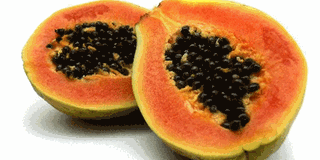Papaya: How to grow wonder health fruit

Pawpaw fruit. NATION MEDIA GROUP
What you need to know:
- Papayas come in a wide range of sizes, shapes and flesh colour, all depending on the variety grown, but fruits from a female plant are generally rounder and sweeter than those from a male plant.
- A papaya grower in DRC once told me that he differentiates male and female seeds by their colours. He claims that the darker seeds, which are not covered in a skin are the female seeds, while the greyish-greenish seeds covered in the translucent skin are the male seeds.
- There is no known resistance to the virus, but it can be controlled though quarantine, destruction of the affected plant and netting to prevent insect vectors from spreading the virus.
Pawpaw is one of my favourite fruits because it grows so easily and is very healthy.
There are several different varieties, of which the Hawaiian varieties ‘Sunrise Solo’ and ‘Solo’ are my personal favourites. They taste great, are the right size for one portion and are not genetically modified. GMO contamination is one of the biggest issues with papaya varieties from Hawaii.
Papayas come in a wide range of sizes, shapes and flesh colour, all depending on the variety grown, but fruits from a female plant are generally rounder and sweeter than those from a male plant.
Papayas have three sexes, female, male and hermaphrodite, (meaning both sexes in one plant). Usually only female and hermaphrodite plants are grown for fruit. Hermaphrodite plants are self-fertilising, while in a plantation of female papayas every fifteenth plant should be male.
SEXING PAPAYAS
It is assumed that Papayas can only be sexed once they started flowering. Female Papayas will have flowers which are single and attached directly to the stem, while male flowers are clustered and grow on a long stalk dangling from the stem. Hermaphrodite flowers look very similar to female flowers, but often grow in small clusters.
A papaya grower in DRC once told me that he differentiates male and female seeds by their colours. He claims that the darker seeds, which are not covered in a skin are the female seeds, while the greyish-greenish seeds covered in the translucent skin are the male seeds.
He didn’t mention hermaphrodite seeds though. I use this method to choose seeds for papaya growing with quite good success, but couldn’t find any scientific proof for this method.
Papaya require well-draining soil, rich in organic matter. Water-logging must be avoided. Heavy soils should be improved with good quality compost. Regular mulching with compost is recommended throughout the lifespan of the tree.
After the first harvest, chicken manure can be applied as well to provide enough nutrients for future crops. Soil pH needs to be between 5.5 and 7.5
Papaya are warm-season plants and do best in the hotter lowland areas. For cooler highland areas Mountain Papayas (Vasconcellea pubescence) are more suitable. Prepare a big planting hole for single trees or a ridge, on which the papaya can be planted in a row.
Incorporate rock phosphate into the soil at a rate of one handful per tree to induce flowering and improve fruit set. Plant the seeds 1cm deep. The recommended spacing is 1.5m (between trees) and 3-4m (between rows).
If you use seedlings ensure to transplant with the roots undisturbed and the whole soil from the seed pot attached. Papayas have a taproot and suffer from transplanting if the roots are disturbed too much. Uproot weeds around the trees regularly. Mulching is highly recommended.
AVOID WATER LOGGING
Water regularly until well established. Afterwards irrigation is only needed under dry conditions at a rate of about 30mm per week (30 litres per square meter), but waterlogging must be avoided. If several plants were grown per plant hole, all but one female or hermaphrodite should be cut back at flowering stage. Papaya can be grown year round. If transplanting, it should be done after 8-10 weeks. Transplanting should be timed to coincide with the rainy season.
The first harvest from a papaya can be expected after about a year and the tree can continue to bear fruits for 3-4 years before it becomes exhausted. The lower fruits are the first to ripen and harvesting can continue for several months.
Fruits can be harvested when they start changing their colour from green to yellow. Sugar content will not increase after harvest, it will only soften. If fruits are kept on the tree for too long they might be damaged by birds and fruit flies.
A papaya is ready for consumption once the area around the petiole starts to soften. To harvest, fruits can be twisted or cut off.
Major diseases in Papaya are papaya ringspot and powdery mildew. Common pests are mealy bugs and mites. The papaya ringspot is transmitted between plants by mechanical activities like pruning and by numerous aphid species.
There is no known resistance to the virus, but it can be controlled though quarantine, destruction of the affected plant and netting to prevent insect vectors from spreading the virus.
Powdery mildew is promoted by high humidity (80-85%) and a temperature range of 24-26°C. Infection is first apparent on the leaves as small slightly darkened areas, which later become white powdery spots.
These spots enlarge and cover the entire leaf area. Severely infected leaves may become chlorotic and distorted before falling. Affected fruits are small in size and malformed.
Dusting Sulphur (30 g/10 litres of water) or spraying Calixin 75 EC (5 ml/10 litres of water) at 15 days interval helps to control the disease when detected early.
Mites, which feed on the plant causing premature leaf drop, and external blemishes on the fruit, cause widespread damage in a very short time. Mites can be controlled by sulphur dustings at rates recommended by manufacturers.
The writer is the country manager, Soilscare




